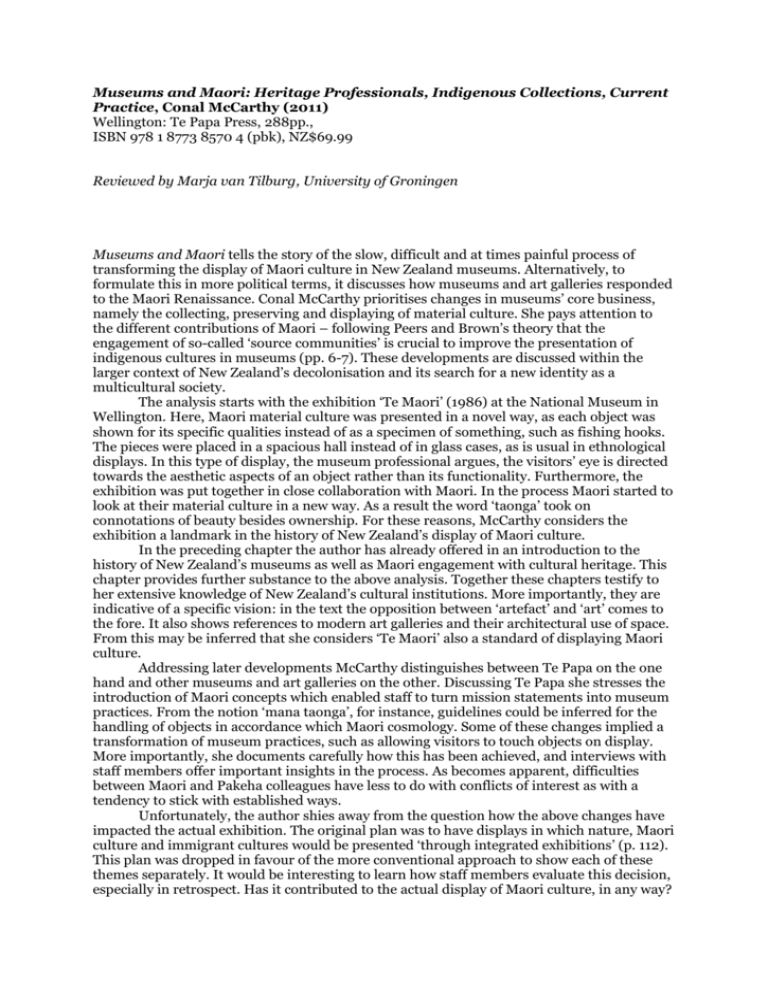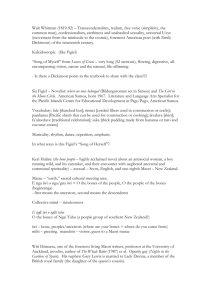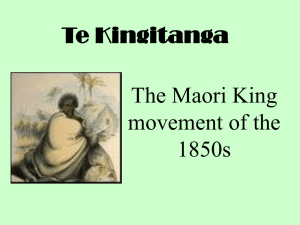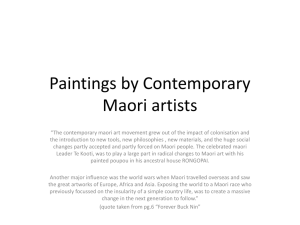Museums and Maori: Heritage Professionals, Indigenous
advertisement

Museums and Maori: Heritage Professionals, Indigenous Collections, Current Practice, Conal McCarthy (2011) Wellington: Te Papa Press, 288pp., ISBN 978 1 8773 8570 4 (pbk), NZ$69.99 Reviewed by Marja van Tilburg, University of Groningen Museums and Maori tells the story of the slow, difficult and at times painful process of transforming the display of Maori culture in New Zealand museums. Alternatively, to formulate this in more political terms, it discusses how museums and art galleries responded to the Maori Renaissance. Conal McCarthy prioritises changes in museums’ core business, namely the collecting, preserving and displaying of material culture. She pays attention to the different contributions of Maori – following Peers and Brown’s theory that the engagement of so-called ‘source communities’ is crucial to improve the presentation of indigenous cultures in museums (pp. 6-7). These developments are discussed within the larger context of New Zealand’s decolonisation and its search for a new identity as a multicultural society. The analysis starts with the exhibition ‘Te Maori’ (1986) at the National Museum in Wellington. Here, Maori material culture was presented in a novel way, as each object was shown for its specific qualities instead of as a specimen of something, such as fishing hooks. The pieces were placed in a spacious hall instead of in glass cases, as is usual in ethnological displays. In this type of display, the museum professional argues, the visitors’ eye is directed towards the aesthetic aspects of an object rather than its functionality. Furthermore, the exhibition was put together in close collaboration with Maori. In the process Maori started to look at their material culture in a new way. As a result the word ‘taonga’ took on connotations of beauty besides ownership. For these reasons, McCarthy considers the exhibition a landmark in the history of New Zealand’s display of Maori culture. In the preceding chapter the author has already offered in an introduction to the history of New Zealand’s museums as well as Maori engagement with cultural heritage. This chapter provides further substance to the above analysis. Together these chapters testify to her extensive knowledge of New Zealand’s cultural institutions. More importantly, they are indicative of a specific vision: in the text the opposition between ‘artefact’ and ‘art’ comes to the fore. It also shows references to modern art galleries and their architectural use of space. From this may be inferred that she considers ‘Te Maori’ also a standard of displaying Maori culture. Addressing later developments McCarthy distinguishes between Te Papa on the one hand and other museums and art galleries on the other. Discussing Te Papa she stresses the introduction of Maori concepts which enabled staff to turn mission statements into museum practices. From the notion ‘mana taonga’, for instance, guidelines could be inferred for the handling of objects in accordance which Maori cosmology. Some of these changes implied a transformation of museum practices, such as allowing visitors to touch objects on display. More importantly, she documents carefully how this has been achieved, and interviews with staff members offer important insights in the process. As becomes apparent, difficulties between Maori and Pakeha colleagues have less to do with conflicts of interest as with a tendency to stick with established ways. Unfortunately, the author shies away from the question how the above changes have impacted the actual exhibition. The original plan was to have displays in which nature, Maori culture and immigrant cultures would be presented ‘through integrated exhibitions’ (p. 112). This plan was dropped in favour of the more conventional approach to show each of these themes separately. It would be interesting to learn how staff members evaluate this decision, especially in retrospect. Has it contributed to the actual display of Maori culture, in any way? What do Maori museum professionals think of the exhibition as it is now? Such questions are not raised, in the same way that (scholarly) critique of the exhibition as a whole is left unmentioned. Perhaps questions regarding representation are not brought to the fore, because the modern, spacious Maori section is up to McCarthy’s standards. Describing developments in other museums and galleries, the author traces each institution’s specific development. The achievements vary tremendously, as can be expected. The results depend not only on local councils’ commitment or funding as some museum professionals could achieve a lot in collaboration with local iwi. Because the focus is very much on results, questions are hardly raised. An example can be found in the handling of human remains. Museums seek to exchange koiwi, so that each person will come to rest in a museum near his or her home. This policy is not criticised, even though different policies have been developed in other countries. Most museums nowadays return human remains to the rightful owners, thus acknowledging that collecting skulls and bones was wrong in the first place because it implied the objectifying of humans following pseudo-scientific theories. Instead of evaluating what progress is made in every individual institution, McCarthy engages critically with the policies to transform conventional museums into bicultural institutions. The last chapters offer a range of opinions of museum professionals regarding aims, strategies and results. Suggesting this discussion will not be abated any time soon, the book argues for a pragmatic approach by showing how museums got as far as they did, and the analysis testifies to the long learning curve. This is the strength of the book, and as such it has a lot to offer to museum professionals looking for ways to transform conventional, dominantly western institutions. In today’s world, this applies to most heritage professionals – in New Zealand and in the rest of the world.








